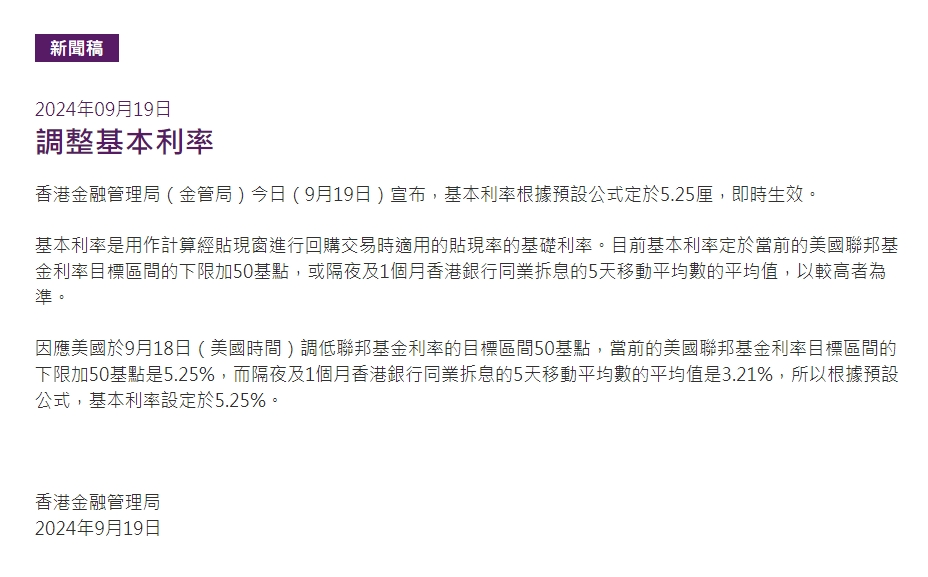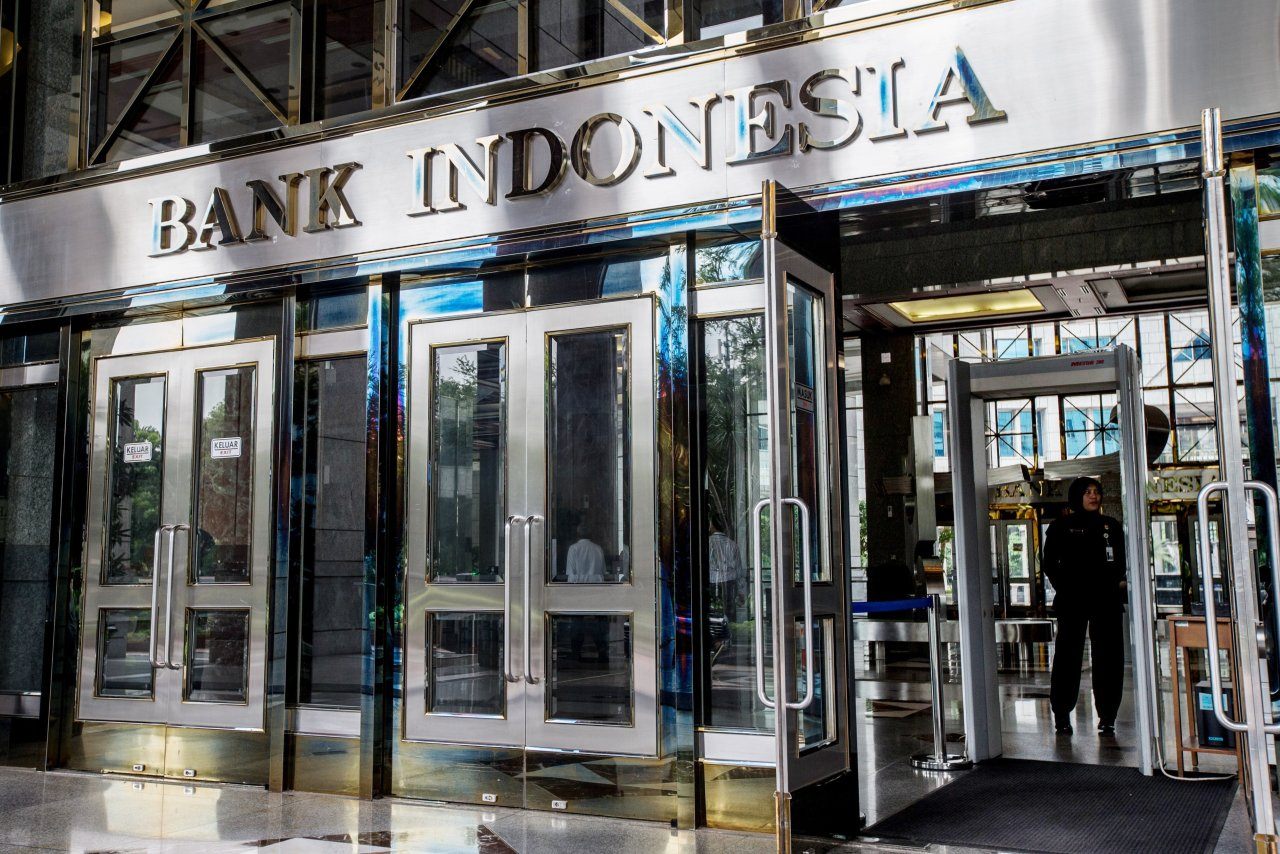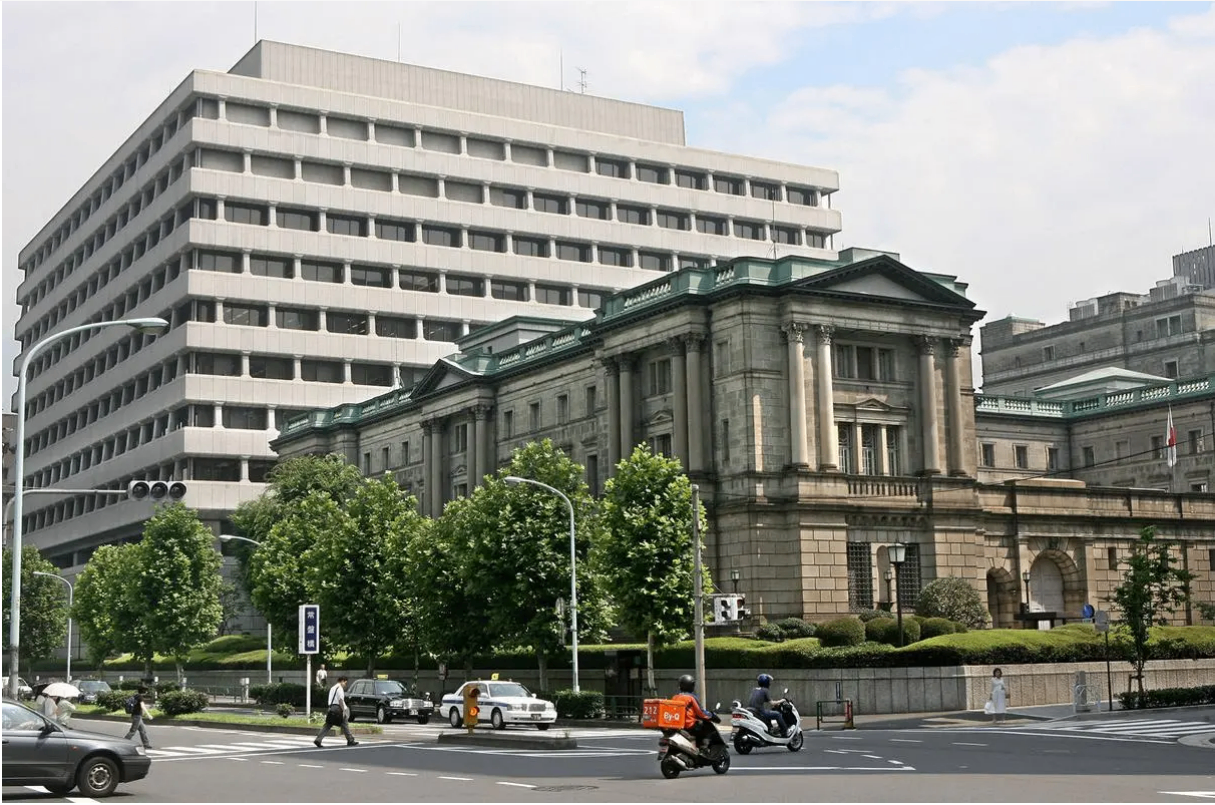A look at the global central bank rate cut situation after the Fed cut interest rates
A number of other countries are already on the brink of a rate cut cycle, most of them in Southeast Asia.
On September 19th, multiple central banks successively cut interest rates following the Federal Reserve's lead.
Central Banks Closely Following the Federal Reserve's Rate Cut
First was Hong Kong, which operates under a linked exchange rate system (with the Hong Kong dollar exchange rate maintained at 1 US dollar to 7.75-7.85 Hong Kong dollars), announcing a rate cut of 50 basis points to 5.25%.
According to the Hong Kong Monetary Authority, the current basic interest rate in Hong Kong is set at the lower bound of the current US federal funds rate target range plus 50 basis points, or the average of the 5-day moving average of the overnight and 1-month Hong Kong interbank offered rates, whichever is higher.
Due to the United States lowering the target range of the federal funds rate by 50 basis points on September 18th (US time), the lower bound of the current US federal funds rate target range plus 50 basis points is 5.25%, while the average of the 5-day moving average of the overnight and 1-month Hong Kong interbank offered rates is 3.21%. Therefore, according to the preset formula, the basic interest rate is set at 5.25%.

In addition to Hong Kong, several central banks in the Middle East have also recently followed suit with rate cuts, with the magnitude of the cuts all being 50 basis points or more.
- Ranked by the magnitude of the rate cut, the Central Bank of Qatar is the most aggressive, cutting the deposit rate by 55 basis points to 5.2%, the repurchase rate by 55 basis points to 5.45%, and the lending rate by 55 basis points to 5.70%, a greater reduction than the Federal Reserve;
- The Saudi Arabian Monetary Authority cut the repurchase rate by 50 basis points to 5.5%, and the reverse repurchase rate was lowered to 5%;
- The Central Bank of the United Arab Emirates cut the overnight deposit rate by 50 basis points to 4.90%;
- The Central Bank of Bahrain cut the overnight deposit rate by 50 basis points to 5.50%;
- The Central Bank of Kuwait announced a rate cut of 25 basis points to 4%.

Despite the relatively low inflation rate in the Gulf region, policy makers in the area have limited room for maneuver in monetary policy due to the peg to the US dollar. They often keep in sync with the Federal Reserve's policies, especially after the economic fluctuations triggered by the COVID-19 pandemic, they have been closely monitoring the Federal Reserve's interest rate adjustments.
Regarding these countries' closely following the Federal Reserve's rate cut, Monica Malik, Chief Economist at Abu Dhabi Commercial Bank, stated before the Federal Reserve's rate cut decision that the Gulf countries do not need to maintain a high interest rate level like the United States.
She explained that this is because the inflation rates in these countries are usually low, mostly kept below 2%. She believes that a rate cut would be a positive move, especially against the backdrop of weak oil price expectations, which would help increase the financing needs of Gulf countries and their investment projects.
Central Banks That Cut Rates Before the Federal Reserve
In fact, the collective rate cut by Gulf countries is not an isolated case. As early as before the Federal Reserve's rate cut, many countries had already sounded the horn for rate cuts.
- In chronological order, in March of this year, the Swiss National Bank fired the "first shot" of the global rate cut year in 2024, and Switzerland became the first developed Western country to announce a rate cut; in June, the central bank once again reduced borrowing costs to 1.25%;
- In May of this year, the Riksbank of Sweden announced a rate cut of 25 basis points, marking the central bank's first rate cut in eight years;
- In June of this year, the European Central Bank lowered the main refinancing operations rate, the marginal lending facility rate, and the deposit facility rate by 25 basis points each, marking the bank's first rate cut since 2019;
- In July of this year, the Bank of England announced a rate cut of 25 basis points, reducing the benchmark rate from 5.25% to 5%, the first rate cut since March 2020;
- On August 14th, the Reserve Bank of New Zealand unexpectedly announced a rate cut of 25 basis points, reducing the benchmark rate from 5.5% to 5.25%;
- On August 15th, the Central Bank of the Philippines announced a rate cut of 25 basis points;
- On September 4th, the Bank of Canada lowered the key interest rate by 25 basis points to 4.25%, marking the third consecutive rate cut this year; in July and June, the Bank of Canada cut the benchmark rate twice, lowering it to 4.5%; another rate cut of 25 basis points in October is almost a foregone conclusion;
- On September 12th, the European Central Bank announced its second rate cut of the year, lowering the deposit facility rate by 25 basis points, and both the main refinancing operations rate and the marginal lending facility rate by 60 basis points, bringing the three main rates to 3.50%, 3.65%, and 3.90% respectively;
- On September 18th, Bank Indonesia decided to lower the benchmark rate by 25 basis points to 6%, while also lowering the deposit rate to 5.25% and the lending rate to 6.75%;
Central Banks Expected to Cut Rates in the Future
In addition, many countries are on the verge of a rate-cutting cycle, with Southeast Asia being the most represented—Philippines took the lead in cutting rates in August, and Indonesia, supported by strong expectations of a rate cut by the Federal Reserve, lowered its key interest rate level on Wednesday this week. J.P. Morgan Chase expects India to cut rates next month, while the central banks of South Korea and Thailand are expected to take action before the end of this year.
Analysts say that due to the greater room for monetary policy easing by central banks in Southeast Asian countries, the local market outlook is generally optimistic.
Usually, when central banks lower interest rates, it leads to the devaluation of their domestic currency. For emerging market countries, if they lower interest rates before the Federal Reserve, they may face a decrease in currency value, reduced investment attractiveness, and increased import costs, which could potentially lead to inflation.
However, with the Federal Reserve's recent announcement of a 50 basis point rate cut, this has provided room for other central banks that have not yet adopted an easy monetary policy to cut rates, especially central banks in Asia, particularly in Southeast Asia, which can now join the rate-cutting ranks with more confidence.
Analysts say that over the past two months, fund managers have continued to increase their holdings of sovereign bonds in Thailand, Indonesia, and Malaysia. For three months, they have been net buyers of stocks in Indonesia, Malaysia, and the Philippines. These capital inflows have helped Southeast Asian currencies become the best-performing currencies in the emerging markets this quarter.

Central Banks Requiring Special Attention: Japan, China
In this round of rate cuts, Japan is a special case, as the country has achieved the long-desired stable inflation, and the market expects that Japan may raise interest rates again in December. At the end of July, the Bank of Japan unexpectedly announced a rate hike, adjusting the policy rate from 0-0.1% to 0.25%, causing a financial tsunami.
Analysts say that, based on the potential impact of the Bank of Japan's policy on yen carry trades, the outlook for the Bank of Japan's monetary policy has become as crucial as that of the Federal Reserve. The recent consecutive statements by Bank of Japan officials, as well as the current market expectations, all suggest that the Bank of Japan will continue to raise interest rates.
As of now, most economists surveyed by Reuters expect the Bank of Japan to raise interest rates again this year, with more than three-quarters of them betting that the next rate hike will be in December.
As for China, in order to emerge from deflation, the People's Bank of China may adjust the tone of its monetary policy. Lian Ping, Chairman of the China Chief Economists Forum, expects that under the Federal Reserve's rate-cutting cycle, China's monetary policy tone has gained a rare window of opportunity for adjustment, with space for a new round of reserve requirement ratio cuts and interest rate cuts.
Hua Jin Securities believes that it is imperative for monetary policy to shift to a supportive neutral stance, with supply determined by demand and sufficient quantity and stable prices being the current more reasonable monetary policy expectations, maintaining the forecast of a 50bp reserve requirement ratio cut by the People's Bank of China in September.

·Original
Disclaimer: The views in this article are from the original Creator and do not represent the views or position of Hawk Insight. The content of the article is for reference, communication and learning only, and does not constitute investment advice. If it involves copyright issues, please contact us for deletion.